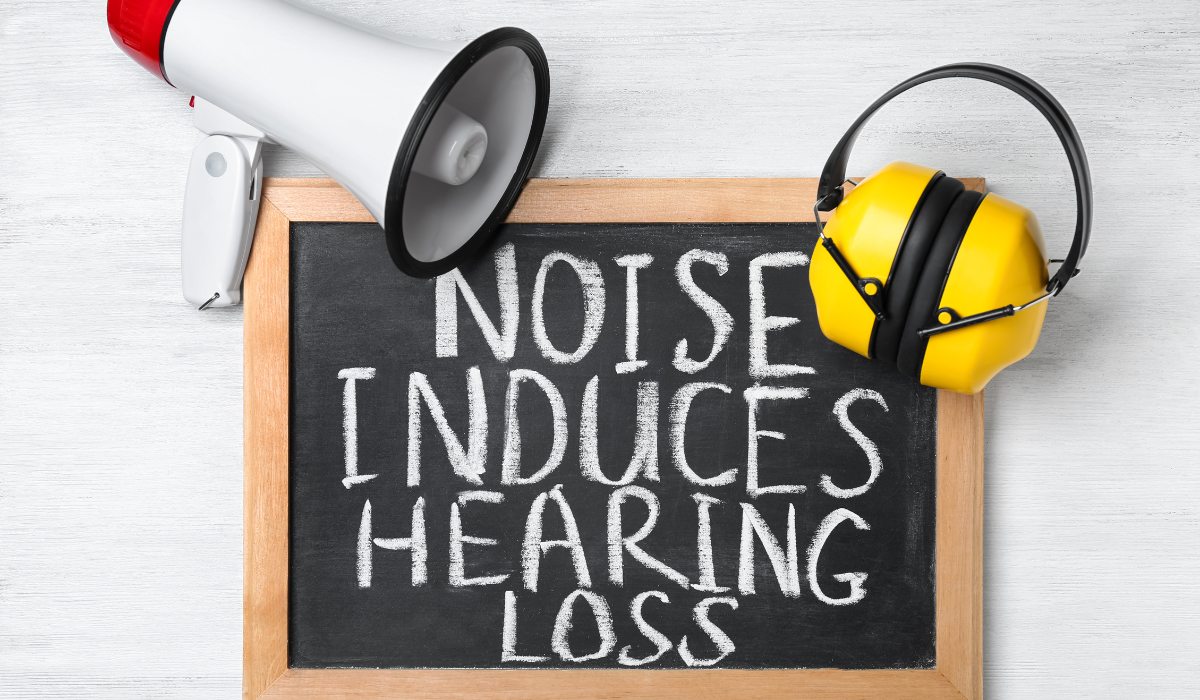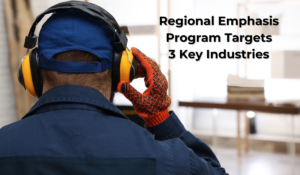In a recent announcement, the U.S. Department of Labor revealed the renewal of a Regional Emphasis Program (REP) aimed at directing inspections towards industries with heightened workplace noise levels in three Mid-Atlantic States and the District of Columbia.
With a focus on preventing worker hearing loss, this initiative underscores the importance of proactive measures in protecting your employees from the potential permanence and debilitation associated with auditory impairment.
So, which industries are affected, and why is the Regional Emphasis Program being renewed?
Let’s take a look at a few stats, who the REP affects, and the key steps you can take.
Related Article: Exploring 10 PPE Items for Your Hearing Conservation Program
Related Article: 7 Steps for Preventing Occupational Hearing Loss

The Scope of Hearing Loss: A Widespread Workplace Hazard
Hearing loss, a prevalent occupational health issue, holds the potential to be both permanent and debilitating. And, though largely preventable, it’s one of the most common problems workers encounter.
So, just how common is it? Just take a look at a few key stats:
- According to estimates from the National Institute Occupational Safety and Health (NIOSH), approximately 22 million U.S. workers face the hazard of potential hearing loss.
- Alarming data from the Bureau of Labor Statistics in 2021 reported that 12,000 workers suffered work-related hearing loss, with a substantial 9,700 of these cases stemming from the manufacturing industry. Additionally, more than 20,000 workplace hearing loss cases occur yearly. Unfortunately, many of these cases result in permanent hearing loss.
- Over 30 million workers in the U.S work with or near ototoxic chemicals, which can damage hearing.
- According to the Center for Disease Control and Prevention [CDC], almost a quarter of hearing issues experienced by U.S. workers can be attributed to occupational exposures. Another alarming CDC statistic reveals that 34% of workers exposed to hazardous noise are not provided hearing protection.
In order to reduce the number of occupational hearing loss cases, it’s critical employers provide workers with appropriate hearing protection.
- Mining (17%), construction (16%), and manufacturing (14%) have the highest prevalence of workers with hearing loss. These workers are exposed to high levels of noise from loud machinery daily.
OSHA’s Renewed Regional Emphasis Program
Program Overview:
The Occupational Safety and Health Administration (OSHA) in Philadelphia has renewed its REP, initially established in 2018, with a particular focus on industries with high levels of workplace noise.
The renewal encompasses a five-year term and directs OSHA’s efforts towards manufacturing industry employers under federal jurisdiction in Delaware, Pennsylvania, West Virginia, and the District of Columbia.
New Emphasis Sectors:
As part of the October renewal, OSHA has expanded the REP by incorporating three additional manufacturing industry sectors.
Recent data indicates elevated risk levels of noise exposure in the following industries – sawmills and wood preservation, other wood manufacturing, and ornamental & architectural metal products.
So, if you’re operating within those sectors, be aware of potential extra scrutiny from OSHA.
Encouraging Compliance and Safety Strategies
OSHA Regional Administrator Michael Rivera, based in Philadelphia, underscores the pivotal role of noise controls as the primary prevention against permanent work-related hearing loss.
Even a modest reduction in noise levels can significantly enhance employee protection, foster better communication, and curtail excessive noise distractions within the workplace.
Rivera also emphasizes that the renewed REP serves as a reminder to manufacturing employers in the specified regions, highlighting the importance of following federal safety standards to shield workers from avoidable and potentially irreversible harm.
For those operating in high-risk noise industries, OSHA urges employers to adhere to federal safety standards for noise protection.
Assistance for Small Employers
Recognizing the diverse landscape of employers, OSHA encourages small businesses to utilize the On-Site Consultation Program. This confidential, no-cost assistance initiative offers guidance on safety strategies and compliance with federal safety and health standards.
The program remains separate from OSHA enforcement, and provides employers a way to identify and correct any potential problems, before they become a fineable offense.
OSHA area offices in Pennsylvania, including Allentown, Erie, Harrisburg, Philadelphia, Pittsburgh, and Wilkes Barre, along with offices in Wilmington, Delaware, and Charleston, West Virginia, are actively engaged in inspections and offering assistance.
Legal Mandates and Guidelines
Hearing Conservation Program:
To address and prevent noise-induced hearing loss, OSHA mandates employers to implement a hearing conservation program when the average noise exposure over 8 working hours reaches or exceeds 85 decibels.
This benchmark, compared to the sound of city traffic or a gas-powered leaf blower by the Centers for Disease Control and Prevention, triggers the need for protective measures.
Guidelines for Employers:
In the pursuit of preventing noise-induced hearing loss, OSHA provides employers with comprehensive hearing conservation guidelines.
These guidelines serve as a roadmap for employers to implement effective strategies and safeguards within the workplace.
These programs should include:
- Regular noise monitoring
- Audiometric testing
- Employee education and training
- Ongoing evaluation of control measures.
These programs enable early detection of hearing loss, prompt intervention, and ensure compliance with relevant regulations.
- See OSHA Guideline on Hearing Conservation Program [95(c)]
- See OSHA Guideline on Hearing Conservation Program for Construction Workers [95, 52, 1926.101]
- See OSHA Guidelines on Occupational Noise Exposure; exposure and controls
Key Takeaways
As the U.S. Department of Labor renews its commitment to prioritizing auditory health through the REP, preventing workplace-induced hearing loss becomes more crucial than ever.
By integrating proactive measures, emphasizing compliance, and providing valuable resources, OSHA strives to create workplaces where the cacophony of noise doesn’t overshadow the well-being of the workforce, ensuring your employees can continue their professional journeys with their auditory health intact.
Mobile Audiometric Testing
For audiometric testing, which is required by OSHA, Worksite Medical brings the examinations directly to your worksite. Employers must make audiometric testing available at no cost to all employees who are exposed to an action level of 85 dB or above, measured as an 8-hour TWA.
You can get up to six audio booths and up to 20 exams per hour for efficient testing. Audiometric testing is pure tone air-conducted hearing testing performed in each ear at frequencies of 500, 1K, 2K, 3K, 4K, 6K, and 8K. This sort of testing identifies hearing levels and sensitivity to the exposed sound.
We also provide hearing safety training. And, you never have to send your team members away to a clinic. Get your risk-free quote or schedule your on-site audiometric exams below. Let’s keep your team safe and stay ahead of OSHA inspections together.
Take a virtual tour of our mobile medical units HERE.
About Worksite Medical
In most cases, OSHA requires medical surveillance testing, and at no cost to employees.
Worksite Medical makes that program easier with mobile medical testing.
We conduct on-site respirator fit tests, as well as audiometric exams, pulmonary function tests and heavy metal lab work, right on your job site. We also keep accurate, easy-to-access medical records for your convenience. You’ll keep your employees at work, and stay ahead of OSHA inspections.




